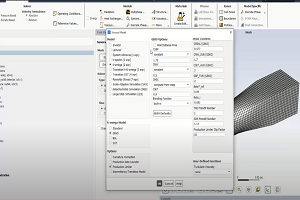For the stress-life fatigue method, how are the Goodman and Gerber mean stress theories used to modify the calculated stress amplitude in the Workbench Fatigue Module?
-
-
June 5, 2023 at 7:04 am
 FAQParticipant
FAQParticipantThe Goodman and Gerber mean stress correction theories are used in the StressLife (SN) fatigue methodology to account for the detrimental effect that tensile mean stresses have on fatigue life. In SN fatigue, the calculated stress amplitude is the maximum stress range for a cycle of loading. It is used in conjunction with a stress vs cycles (S-N) curve to determine the number of cycles to failure for that loading. The Goodman/Gerber theories modify the calculated stress amplitude to determine an effective stress amplitude that includes the effect of the mean stress. The effective stress amplitude is the calculated stress amplitude multiplied by the mean stress correction factor (1.0 minus the ratio of the mean stress to the ultimate stress raised to an exponent). Sa = [1-(Sm/Su)^n] * Seff For the Goodman theory, the exponent (n) is 1.0 (linear correction). For the Gerber theory, the exponent is 2.0 (parabolic correction). Note: The Goodman correction is more conservative, but comparisons to test results indicate that the Gerber correction is usually more accurate.
-


Introducing Ansys Electronics Desktop on Ansys Cloud
The Watch & Learn video article provides an overview of cloud computing from Electronics Desktop and details the product licenses and subscriptions to ANSYS Cloud Service that are...

How to Create a Reflector for a Center High-Mounted Stop Lamp (CHMSL)
This video article demonstrates how to create a reflector for a center high-mounted stop lamp. Optical Part design in Ansys SPEOS enables the design and validation of multiple...

Introducing the GEKO Turbulence Model in Ansys Fluent
The GEKO (GEneralized K-Omega) turbulence model offers a flexible, robust, general-purpose approach to RANS turbulence modeling. Introducing 2 videos: Part 1 provides background information on the model and a...

Postprocessing on Ansys EnSight
This video demonstrates exporting data from Fluent in EnSight Case Gold format, and it reviews the basic postprocessing capabilities of EnSight.

- Question: What is the difference between PLNSOL, EPPL, EQV and PLNSOL,NL,EPEQ?
- How to use layered section to simulate composites and post process the results in ANSYS Mechanical
- Guidelines of modeling a gasket.
- ANSYS Mechanical: Delamination Analysis using Contact Debonding
- For the stress-life fatigue method, how are the Goodman and Gerber mean stress theories used to modify the calculated stress amplitude in the Workbench Fatigue Module?
- Why is the unit of the elastic foundation stiffness N/m^3?
- How do I move a material property from Engineering Data to an existing Material Library?
- Hyperelastic Simulations
- What are Isochronous stress-strain curves? How can they be used in ANSYS for modeling creep?
- How do I enter major Poisson’s ratio in ANSYS Mechanical?

© 2025 Copyright ANSYS, Inc. All rights reserved.

